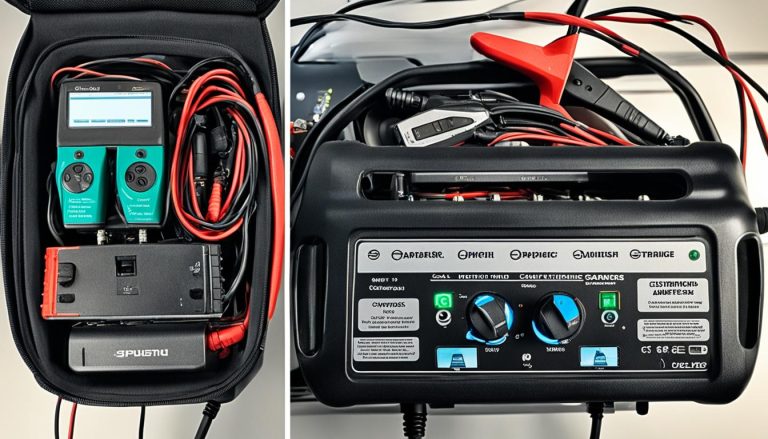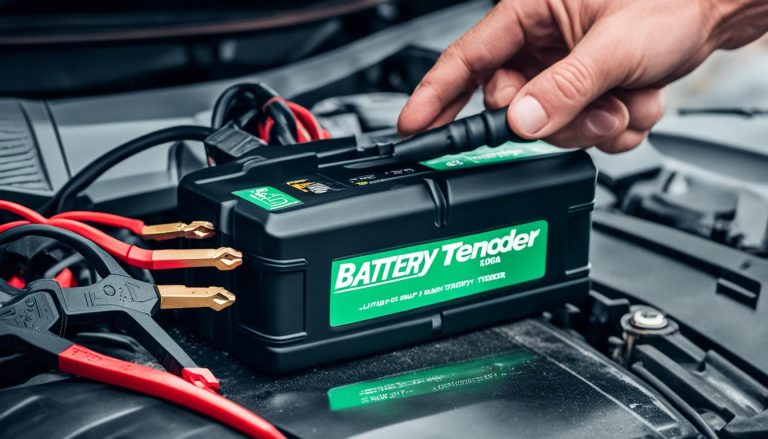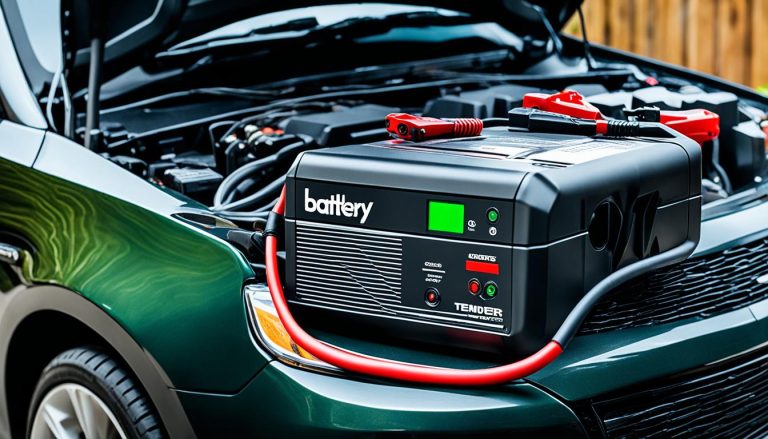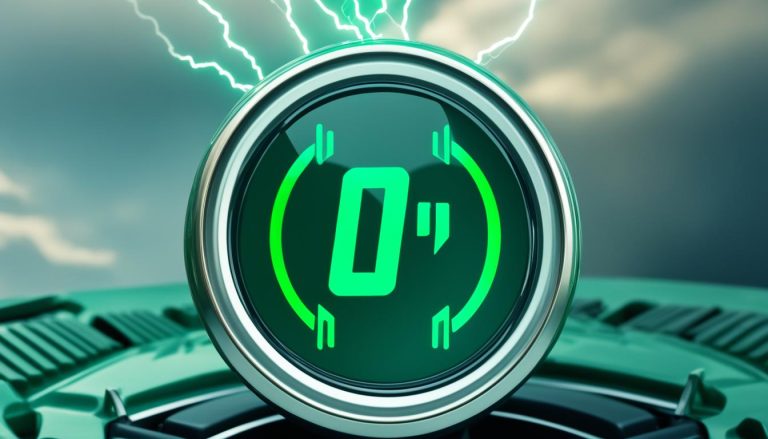Jump Start a Motorcycle Battery Easily | Quick Guide
batterychargers.site and its partners may earn a commission if you purchase a product through one of our links
Ever been ready to ride, only to be greeted by the dreaded silence of a dead battery? You’re not alone. Learning how to jump start a motorcycle battery is a valuable skill that can save you from delays and frustration. This quick guide to jump starting a motorcycle battery empowers you with knowledge to get back on the road with minimal downtime. Whether you’ve left your lights on or your bike has been sitting a touch too long, understanding the right way to perform a motorcycle battery jump start can mean the difference between a ruined day and a thrilling ride. Let’s get you prepared for those moments with practical advice and safety tips.
Key Takeaways
- A reading above 12 volts often means your battery is jumpable.
- Carry a set of motorcycle jumper cables to address emergencies swiftly.
- Inspect safety switches and wirings before proceeding with a jump start.
- A personal power supply or jump box is a practical tool for quick assistance.
- Adequate knowledge of jump starting safeguards your motorcycle’s electrical integrity.
- Boost your battery’s life by ensuring your alternator is in good health.
- Familiarize yourself with pre-jump safety checks for a secure bike revival process.
Recognizing the Signs of a Battery In Need of a Jump
Addressing the issue early when you notice symptoms of a dead motorcycle battery can save you from being stranded. One telling sign is when your motorcycle barely turns over, signifying a battery that might be due for a motorcycle battery dead jump start. Other signs include dim lights and an ineffective horn, which suggest the battery isn’t providing enough power and could benefit from jump starting a motorcycle battery. Keep an eye out for these symptoms, especially if you find your bike won’t start after being unused over the winter or after leaving accessories on without the engine running.
| Symptom | Possible Cause | Action Required |
|---|---|---|
| Clicking noise when trying to start | Flat battery | Consider a jump start |
| Slow cranking engine | Weak battery charge | Charge or jump start |
| Total silence upon ignition | Dead battery or bad connection | Inspect connections or jump start |
| Dimming headlights | Low battery voltage | Charge or jump start |
| Frequent need for a boost | Old or failing battery | Battery replacement needed |
If you’re experiencing a completely unresponsive motorcycle, it’s a stark warning that the battery is possibly devoid of charge. To ensure you’re dealing with a battery that can be revived, use a voltmeter to check the battery’s voltage. A healthy motorcycle battery should read close to 12.6 volts when the engine is off, and around 13.7 to 14.7 volts when the engine is running.
- Battery voltage substantially lower than 12 volts indicates a dead motorcycle battery.
- A reading of 0 volts could mean a shorted battery.
- If the battery shows voltage but fails to start your bike, it could be due to a bad connection or sulfation.
If jump starting is in order, ensure that you have good-quality jumper cables and a second motorcycle or a jump box that is compatible with your bike. When handled properly, jump starting can be a swift solution to get back on the road.
Remember that while a jump start can help in many cases, it will not resolve an issue with a failing alternator or a battery that has reached the end of its natural life. In these cases, a professional evaluation may be necessary to decide between repairing and replacing the faulty components.
Keep your motorcycle’s battery in peak condition by routinely checking its charge, especially ahead of extended storage periods, and by using a trickle charger during the off-season.
How to Jump Start a Motorcycle Battery
Staring at a motorcycle that refuses to start can be frustrating, but with the right approach and tools, you can breathe life into your bike’s battery in no time. This section will guide you through the essentials for jump-starting your motorcycle battery, making sure you do it safely and correctly.
Essential Tools You’ll Need for the Procedure
Before you begin, it’s important to gather all the necessary motorcycle battery jump start tools. These include a set of motorcycle jumper cables, specifically ones with smaller alligator clips to fit the motorcycle battery’s tight spaces. Additionally, a reliable personal power supply or jump box, and a digital voltmeter or multimeter are key to ensuring that your motorcycle’s battery can indeed be revived.
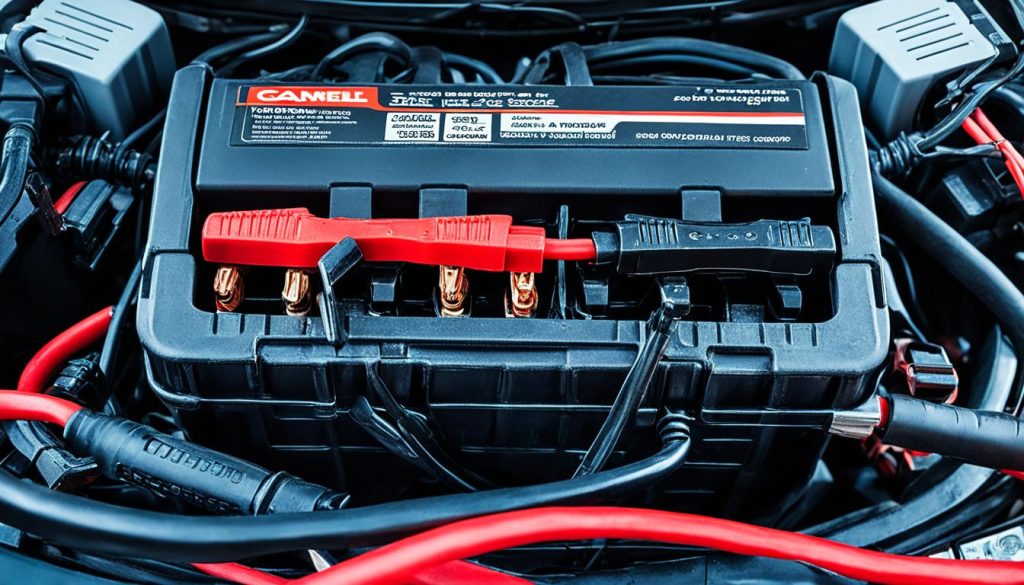
Pre-Jump Safety Checks and Precautions
When it comes to jump start motorcycle battery safely, you can’t skimp on the prep work. This means conducting a thorough check of the motorcycle’s electrical system, including its alternator, and ensuring safety switches, such as the clutch lever and side stand, are correctly engaged. Motorcycle battery jump start precautions are not just about ensuring a successful start but also about protecting you and your bike from potential hazards.
| Pre-Jump Check | Description |
|---|---|
| Alternator Status | Confirm the alternator is not failing to avoid damaging the battery further. |
| Safety Switches | Check the clutch lever and side stand are in the correct positions to allow for starting. |
| Vehicle Condition | Ensure that the car or other motorcycle is off if used as a jump source to prevent overpowering the bike’s electrical system. |
Step-by-Step Motorcycle Battery Jump Start Instructions
Now that you’re equipped and have taken the necessary precautions, it’s time to go through the motorcycle battery jump start procedure. Starting with the dead motorcycle battery, connect the red cable to the positive terminal. Mirror this step on the good battery. Then, attach the black cable to the jumper’s negative terminal and find a grounding metal on the dead motorcycle for the other end. The motorcycle battery jump start instructions below have been designed to ensure the process goes smoothly. Remember, if you’re considering jump starting a motorcycle with a car, it’s essential to keep the car off during the process.
- Connect red cable to the positive (+) terminal of the dead battery.
- Connect the other end of the red cable to the positive terminal of the good battery or power supply.
- Attach one end of the black cable to the negative (-) terminal of the good battery or power supply.
- Connect the other end of the black cable to a metal surface on the dead motorcycle, away from the battery and fuel lines.
- Try to start the motorcycle with a few short ignition attempts, resting a few minutes between tries.
- Once started, let the motorcycle run for a few minutes, then carefully disconnect the cables in reverse order.
- Take the motorcycle for a 15 to 30-minute ride to help recharge the battery.
Following these steps will help ensure your motorcycle’s battery gets the boost it needs to spring back to life. Always prioritize safety and proper technique when handling motorcycle batteries and electrical systems.
Tips for Successful Motorcycle Battery Revival
When you’re facing a motorcycle that won’t start, the right approach can mean the difference between hitting the road and being stuck in the garage. Here, you’ll find essential tips for jump starting a motorcycle battery to ensure a successful motorcycle battery revival. Before you begin, verify that your battery’s voltage is indeed above 12 volts, suggesting that it is primed for a jump start.
Using a charger to slowly top off your motorcycle battery helps in maintaining its health and is a smart step if you’re not in urgent need of a revival. For those times when you have to use a portable jump starter, always check that it’s set to match your bike’s battery voltage. Operation should be in short bursts to prevent damage and, following usage, it’s crucial to recharge your device to keep it ready for your next ride.
Remember, if you’re using another motorcycle or vehicle for the boost, it should be turned off and put in neutral before connecting the cables.
Below is an easy reference table with simple follow-through steps that will help ensure you’re taking the right measures for a smooth and safe jump start with long-term battery health in mind:
| Action | Benefit | Tip |
|---|---|---|
| Check battery voltage | Ensures battery is able to be revived | Should be above 12 volts |
| Use a charger first | Optimizes battery health | Top off slowly if time permits |
| Set portable jump starter correctly | Matches energy needs without overload | Check voltage requirements |
| Recharge jump starter promptly | Ensures tool is ready for future use | Recharge after each use |
| Neutral position for donor vehicle | Prevents possible damage from power surge | Donor vehicle or bike must be off |
By observing these guidelines, you will not only successfully jump start your motorcycle but also take significant strides towards its overall battery longevity. And remember, always handle motorcycle batteries with care and respect, as proper technique not only saves time but also ensures safety.
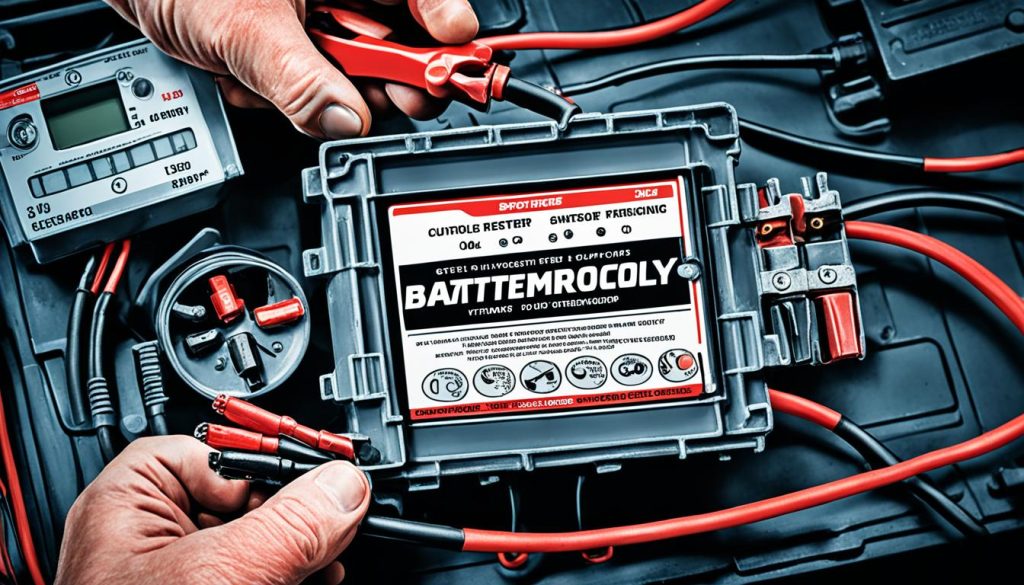
Addressing Common Issues While Jump Starting
Embarking on the endeavor of troubleshooting motorcycle battery jump start troubles can be fraught with challenges. Whether encountering the predicament of a motorcycle won’t start after jumping or dealing with the frustration of a motorcycle battery completely drained, it’s essential to tackle these issues head-on. Even when you’re hopeful about a motorcycle battery dead jump start, it’s prudent to understand the why and how before proceeding with alternative solutions.
What to Do When the Motorcycle Won’t Start After Jumping
If you’ve attempted a jump start, yet your motorcycle stubbornly refuses to roar to life, don’t despair. Start by checking all connections to ensure they are secure and the cables aren’t damaged. If everything appears in order externally, the issue may be more deeply rooted. It may be time to evaluate the charging system or inspect for a potential defective safety switch.
The following table outlines steps to take when faced with a motorcycle that won’t start after jumping, helping guide you through the process:
| Issue | Troubleshooting Steps | Considerations |
|---|---|---|
| Dead Battery | Verify the voltage; if under 12V, battery likely needs replacement. | A deep-discharged battery can sustain damaged cells and lose capacity. |
| Faulty Charging System | Check the stator, regulator, and wiring; may require professional diagnosis. | Frequent jump starting can hint at underlying electrical issues. |
| Defective Safety Switches | Inspect clutch lever and side stand switches for proper function. | Motorcycle safety features can prevent starting if they malfunction. |
Dealing with a Completely Drained Battery
On the chance that your motorcycle battery has been completely drained, options may seem limited. A battery that is unable to maintain a charge post-jump start typically indicates imminent failure. It becomes even more important to consider replacing the battery, as reoccurring jump starts can be harsh on your motorcycle’s electrical system.
Encountering a dead battery can be a nuisance, but with the right approach, you can prevent recurring issues. Always keep in mind the proper maintenance practices and possible need for replacement to avoid the repetition of such starting troubles.
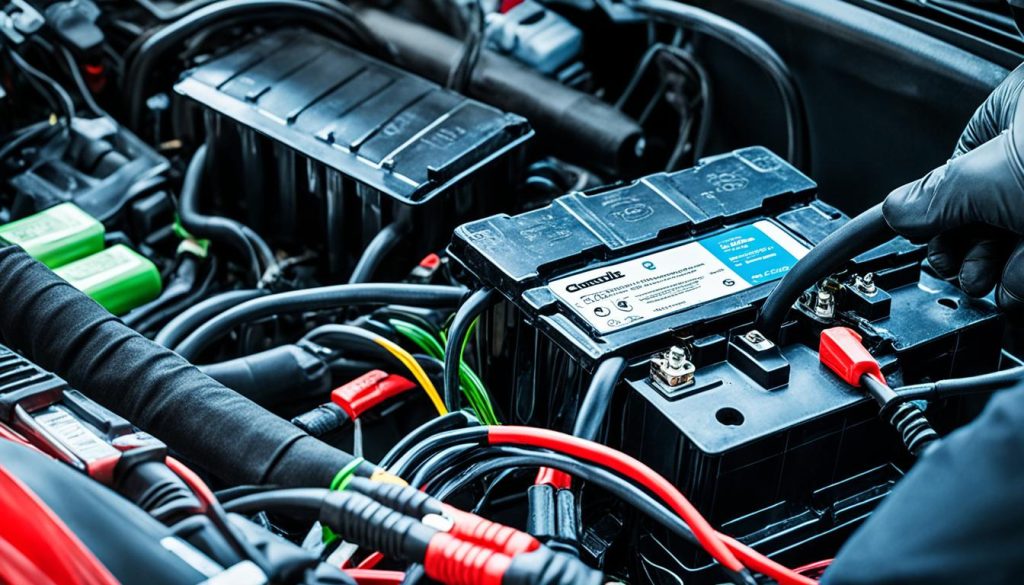
Understanding Battery Maintenance to Prevent Future Dead Batteries
As a motorcycle enthusiast, safeguarding your bike’s battery against unexpected failure not only saves you from inconvenient standstills but ensures your motorcycle is always ready for a ride. Effective motorcycle battery maintenance is key, and it goes well beyond occasional check-ups. Let’s delve into some practical measures you can undertake to maintain your battery’s health and prolong its longevity.
Trickle Charging: A Preventative Measure
The wise use of trickle charging for your motorcycle battery can be likened to regular exercise for your own heart; it keeps it in prime condition and ready to perform when needed. Trickle chargers subtly compensate for the natural discharge that a battery endures, especially during those stretches when you’re not hitting the roads as often. Remember, a trickle charger is particularly advantageous during the colder months, as cold weather is a known nemesis of battery efficiency and life.
Riding Habits That Conserve Battery Life
Did you know your day-to-day riding habits play a pivotal role in your battery’s welfare? To conserve motorcycle battery life, consider how your use of accessories such as heated grips or high-beam lights, especially at low RPMs, might be taxing your battery. Modulate the use of such features based on your alternator’s output. Riding regularly at highway speeds encourages better charge cycles, benefiting battery health. Conversely, adapting your habits to minimize electrical load during city rides goes a long way in promoting battery longevity. Balance is key – enjoying your ride while practicing mindful electrics management ensures your motorcycle’s battery remains in top form.
By embracing these maintenance practices and riding habits, you’ll not just avoid the inconvenience of a dead battery but also extend your battery’s serviceable life, making every ignition as reliable as the sunrise. Armed with this knowledge, you’re not only ready to ride; you’re set to ride smarter.
FAQ
How do I recognize if my motorcycle battery needs a jump start?
You’ll likely notice signs like repeated clicking sounds, slow cranking, or complete silence when you try to start your motorcycle. These symptoms indicate that the battery may not have enough charge to start the engine.
What tools will I need to jump start my motorcycle battery?
You’ll need a set of motorcycle-specific jumper cables, a personal power supply or jump box, and a voltmeter or multimeter to read the battery voltage.
What are the necessary safety precautions before jump starting my motorcycle?
Ensure the motorcycle is not in gear and the safety switches are engaged. If using another vehicle, make sure it is turned off to avoid damaging your motorcycle’s electrical system. Always connect the cables correctly and in the right order to avoid sparking or short-circuiting.
Can you provide a step-by-step guide to jump starting a motorcycle battery?
Sure! Begin by connecting the red cable to the positive terminal of the dead battery, then to the positive terminal of the good battery or power supply. Connect the black cable to the negative terminal of the good battery or power supply, and then to a non-painted metal surface on the motorcycle frame. Attempt to start the motorcycle. If successful, let it run for a few minutes before disconnecting the cables in reverse order.
What tips should I follow to successfully revive my motorcycle battery?
Check the battery voltage is above 12 volts, which indicates it’s jumpable. Use a battery charger for a slow charge if possible. When using a jump box or another vehicle, ensure short bursts when starting and let the bike idle for a few minutes after the jump to recharge the battery.
What should I do if my motorcycle won’t start after trying to jump it?
Check other potential issues such as a failing alternator, faulty safety switches, or damaged wiring. If the battery is completely drained and will not hold a charge, it may need to be replaced.
How do I deal with a completely drained motorcycle battery?
If jump starting doesn’t work, the battery might be past the point of recovery. You should try charging it with a proper battery charger; if that fails, replacement is likely the best option.
What are the best practices for motorcycle battery maintenance to avoid dead batteries?
Regularly use a trickle charger, especially during long periods of inactivity or cold weather. Ensure your motorcycle’s charging system works properly, and avoid drawing too much power when the alternator isn’t charging, such as at low speeds or while idling for extended periods.
What are some riding habits that help conserve my motorcycle battery life?
Minimize the use of high-draw accessories like heated gear when the bike’s engine isn’t at a high enough RPM to produce surplus electricity. Aim to ride at speeds where the alternator generates more power to help maintain a healthy battery charge.



